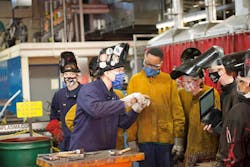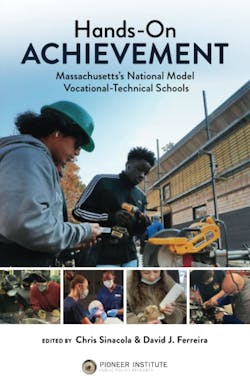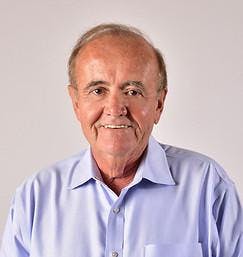A Blueprint for Voc-Tech Education
It’s time.
Time for the educational divide that pits college-prep education tracks against vocational training tracks to close. The two can exist side-by-side, providing both types of education. This is exactly the case in Massachusetts which has a high school system that meets college-prep education standards while also providing training for certification in the trades.
“It is vital to recognize that voc-tec high schools in the Bay State today are true schools of choice,” writes David J. Ferreira, executive director of the Massachusetts Association of Vocational Administrators, in his new book Hands-On Achievement: Massachusetts’s National Model Vocational-Technical Schools.
“The tens of thousands of students who attend them do so not because they are assigned to them by accident of birth, place of residence, or some administrator’s decision, but because they want to be there.”
What are these schools offering that appeal to so many high school students in the Bay state? “What makes us successful is we have become schools of choice, not an alternative school of education," says Ferreira. "Students are attending these schools because a potential career has sparked their interest."
Ferreira feels a new perspective on education is essential. ”We need to prepare high school students for the world of work, so we have to really focus on voc-tech as a priority.”
Ferreira notes that students at these high schools take the same courses as all high schools across the state, as well as courses that can lead to technical certifications. They alternate weeks of academic and vocational education. However, academic education is also geared toward potential careers. “In classroom instruction, the theory is taught in conjunction with practical application. For example, in physics, we teach how these principles are used in the auto industry or the aerospace industry. This type of integrated learning is resonating with our students.”
This type of education can achieve two goals simultaneously. Students can continue onto college, community college or technical colleges as they have mastered all of the requirements, but they also can enter the workforce through apprenticeship programs or straight into a job as the students have earned licenses and industry-recognized credentials.
“The message that we try to get out to parents, and students, is that this provides expanded opportunities. We're a possibility for any student who wants to prepare for both college and earn certifications for a career." Across Massachusetts, 45 state-approved occupational programs are available.
Creating a Spark
To be able to create a system that has so many students choosing high schools that provide vocational education is part of an overall education strategy.
Part of any high school experience is extracurricular activities and for these voc-tec high schools, activities related to STEM fields are available. For example, SkillsUSA, a 50-year-old organization that provides career and technical education at the high school level, works with the schools to provide activities. And like any high school, athletic programs are also available.
Employer Involvement
Business involvement has been key to supporting these high schools. Each of the state’s 26 regional vocational-technical schools works with a committee of local business leaders. They are involved in various activities, including assessing equipment needs, reviewing curriculum and overseeing co-op programs that employ juniors and seniors.
An example of this partnership between educators and the community is the turnaround of Worcester Technical High School. The school wasn’t performing well but after changes in administration, a new building, which was partially funded by area businesses, and added programs such as Advanced Placement courses, the school’s dropout rate was greatly reduced and graduation rates soared.
In fact, in 2014, President Obama gave the commencement speech and said, “The thing I really want to do is make sure that what we’ve learned here, at this high school, we can lift for an entire nation. I want the nation to learn from Worcester Tech."
Companies also hire students from these high schools. Ferreira says this entire ecosystem is beneficial to both students and employers. “Companies that hire these students gain employees that are productive from the first day. They don’t need to go into a training program as they already have a lot of skills. And students earn competitive wages. This is a win-win situation. A student can see what it’s like to work for this company, and the company sees what these students can bring to the table and offer them future opportunities if it’s a match.”
A Blueprint
While a lot of factors have come together over the years to achieve these results, Ferreira believes that other states can replicate them. Recently Pioneer Institute, which published the book and is a state-based advocacy group, issues a toolkit, "Replicating the Massachusetts Model of Vocational-Technical Education".
“Transforming an educational system requires a culture shift,” says Ferreira. “More people are recognizing, in a general sense, that this is not your grandfather’s vocational school.”
Ferreira sees this type of education which combines standard courses with vocational courses as a path that can create a more expansive view of what it means to be successful. “This is a path to a middle-class life that provides a livable wage and allows people to go into professions that they are proud of. It offers a lot of upward trajectories as well since often trade people end up owning their own companies.”


